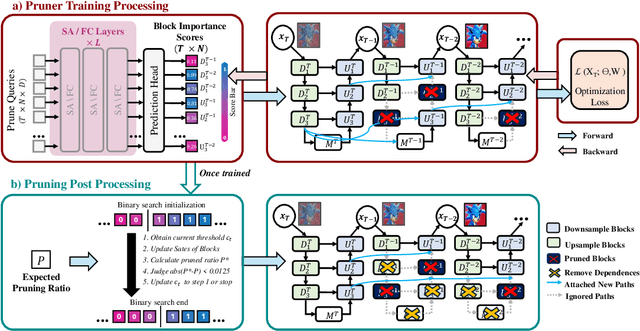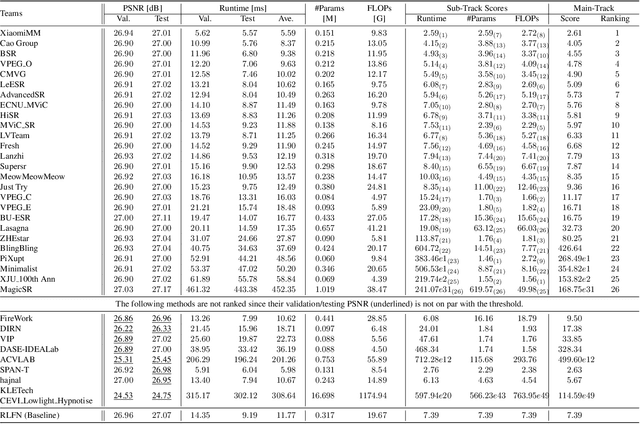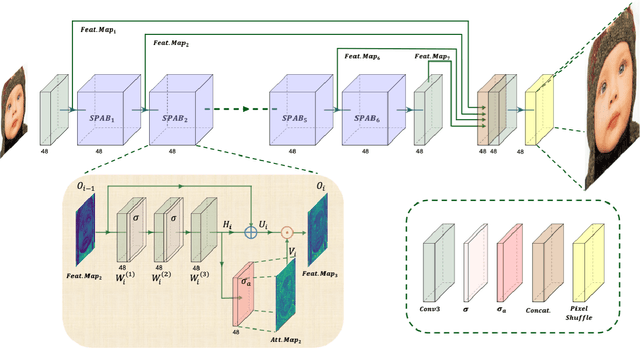Dehua Tang
DiP-GO: A Diffusion Pruner via Few-step Gradient Optimization
Oct 22, 2024



Abstract:Diffusion models have achieved remarkable progress in the field of image generation due to their outstanding capabilities. However, these models require substantial computing resources because of the multi-step denoising process during inference. While traditional pruning methods have been employed to optimize these models, the retraining process necessitates large-scale training datasets and extensive computational costs to maintain generalization ability, making it neither convenient nor efficient. Recent studies attempt to utilize the similarity of features across adjacent denoising stages to reduce computational costs through simple and static strategies. However, these strategies cannot fully harness the potential of the similar feature patterns across adjacent timesteps. In this work, we propose a novel pruning method that derives an efficient diffusion model via a more intelligent and differentiable pruner. At the core of our approach is casting the model pruning process into a SubNet search process. Specifically, we first introduce a SuperNet based on standard diffusion via adding some backup connections built upon the similar features. We then construct a plugin pruner network and design optimization losses to identify redundant computation. Finally, our method can identify an optimal SubNet through few-step gradient optimization and a simple post-processing procedure. We conduct extensive experiments on various diffusion models including Stable Diffusion series and DiTs. Our DiP-GO approach achieves 4.4 x speedup for SD-1.5 without any loss of accuracy, significantly outperforming the previous state-of-the-art methods.
The Ninth NTIRE 2024 Efficient Super-Resolution Challenge Report
Apr 16, 2024



Abstract:This paper provides a comprehensive review of the NTIRE 2024 challenge, focusing on efficient single-image super-resolution (ESR) solutions and their outcomes. The task of this challenge is to super-resolve an input image with a magnification factor of x4 based on pairs of low and corresponding high-resolution images. The primary objective is to develop networks that optimize various aspects such as runtime, parameters, and FLOPs, while still maintaining a peak signal-to-noise ratio (PSNR) of approximately 26.90 dB on the DIV2K_LSDIR_valid dataset and 26.99 dB on the DIV2K_LSDIR_test dataset. In addition, this challenge has 4 tracks including the main track (overall performance), sub-track 1 (runtime), sub-track 2 (FLOPs), and sub-track 3 (parameters). In the main track, all three metrics (ie runtime, FLOPs, and parameter count) were considered. The ranking of the main track is calculated based on a weighted sum-up of the scores of all other sub-tracks. In sub-track 1, the practical runtime performance of the submissions was evaluated, and the corresponding score was used to determine the ranking. In sub-track 2, the number of FLOPs was considered. The score calculated based on the corresponding FLOPs was used to determine the ranking. In sub-track 3, the number of parameters was considered. The score calculated based on the corresponding parameters was used to determine the ranking. RLFN is set as the baseline for efficiency measurement. The challenge had 262 registered participants, and 34 teams made valid submissions. They gauge the state-of-the-art in efficient single-image super-resolution. To facilitate the reproducibility of the challenge and enable other researchers to build upon these findings, the code and the pre-trained model of validated solutions are made publicly available at https://github.com/Amazingren/NTIRE2024_ESR/.
UPDP: A Unified Progressive Depth Pruner for CNN and Vision Transformer
Jan 12, 2024Abstract:Traditional channel-wise pruning methods by reducing network channels struggle to effectively prune efficient CNN models with depth-wise convolutional layers and certain efficient modules, such as popular inverted residual blocks. Prior depth pruning methods by reducing network depths are not suitable for pruning some efficient models due to the existence of some normalization layers. Moreover, finetuning subnet by directly removing activation layers would corrupt the original model weights, hindering the pruned model from achieving high performance. To address these issues, we propose a novel depth pruning method for efficient models. Our approach proposes a novel block pruning strategy and progressive training method for the subnet. Additionally, we extend our pruning method to vision transformer models. Experimental results demonstrate that our method consistently outperforms existing depth pruning methods across various pruning configurations. We obtained three pruned ConvNeXtV1 models with our method applying on ConvNeXtV1, which surpass most SOTA efficient models with comparable inference performance. Our method also achieves state-of-the-art pruning performance on the vision transformer model.
 Add to Chrome
Add to Chrome Add to Firefox
Add to Firefox Add to Edge
Add to Edge